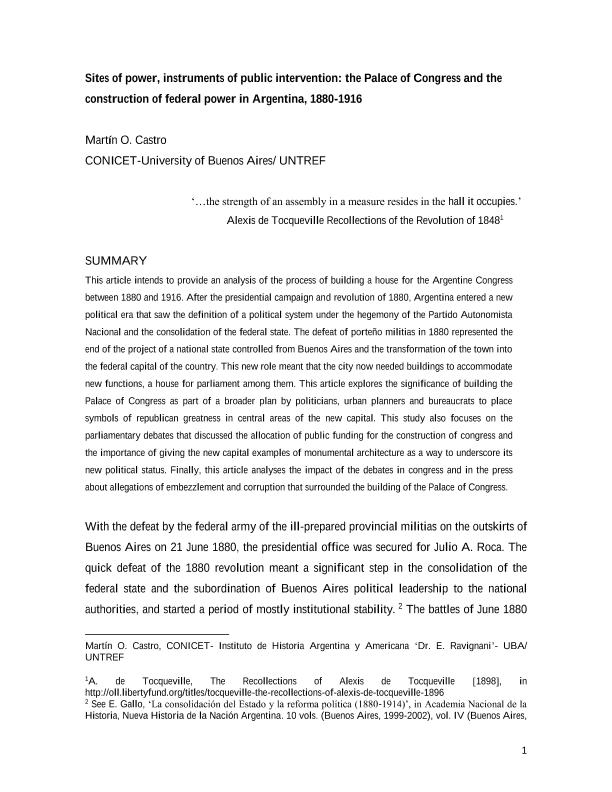Mostrar el registro sencillo del ítem
dc.contributor.author
Castro, Martín Omar

dc.date.available
2018-05-18T14:10:47Z
dc.date.issued
2017-06
dc.identifier.citation
Castro, Martín Omar; Sites of power, instruments of public intervention: the Palace of Congress and the construction of federal power in Argentina, 1880–1916; Taylor & Francis; Parliaments, Estates and Representation; 37; 2; 6-2017; 206-219
dc.identifier.issn
1947-248X
dc.identifier.uri
http://hdl.handle.net/11336/45535
dc.description.abstract
This article intends to provide an analysis of the process of building a house for the Argentine Congress between 1880 and 1916. After the presidential campaign and revolution of 1880, Argentina entered a new political era that saw the definition of a political system under the hegemony of the Partido Autonomista Nacional and the consolidation of the federal state. The defeat of porteño militias in 1880 represented the end of the project of a national state controlled from Buenos Aires and the transformation of the town into the federal capital of the country. This new role meant that the city now needed buildings to accommodate new functions, a house for parliament among them. This article explores the significance of building the Palace of Congress as part of a broader plan by politicians, urban planners and bureaucrats to place symbols of republican greatness in central areas of the new capital. This study also focuses on the parliamentary debates that discussed the allocation of public funding for the construction of congress and the importance of giving the new capital examples of monumental architecture as a way to underscore its new political status. Finally, this article analyses the impact of the debates in congress and in the press about allegations of embezzlement and corruption that surrounded the building of the Palace of Congress.
dc.format
application/pdf
dc.language.iso
eng
dc.publisher
Taylor & Francis

dc.rights
info:eu-repo/semantics/openAccess
dc.rights.uri
https://creativecommons.org/licenses/by-nc-sa/2.5/ar/
dc.subject
Argentina
dc.subject
Congress
dc.subject
Urban History
dc.subject
Public Space
dc.subject.classification
Historia

dc.subject.classification
Historia y Arqueología

dc.subject.classification
HUMANIDADES

dc.title
Sites of power, instruments of public intervention: the Palace of Congress and the construction of federal power in Argentina, 1880–1916
dc.type
info:eu-repo/semantics/article
dc.type
info:ar-repo/semantics/artículo
dc.type
info:eu-repo/semantics/publishedVersion
dc.date.updated
2018-05-17T14:28:21Z
dc.journal.volume
37
dc.journal.number
2
dc.journal.pagination
206-219
dc.journal.pais
Reino Unido

dc.journal.ciudad
Oxford
dc.description.fil
Fil: Castro, Martín Omar. Universidad Nacional de Tres de Febrero; Argentina. Consejo Nacional de Investigaciones Científicas y Técnicas. Oficina de Coordinación Administrativa Saavedra 15. Instituto de Historia Argentina y Americana ; Argentina
dc.journal.title
Parliaments, Estates and Representation
dc.relation.alternativeid
info:eu-repo/semantics/altIdentifier/doi/https://dx.doi.org/10.1080/02606755.2017.1333772
dc.relation.alternativeid
info:eu-repo/semantics/altIdentifier/url/https://www.tandfonline.com/doi/full/10.1080/02606755.2017.1333772
Archivos asociados
